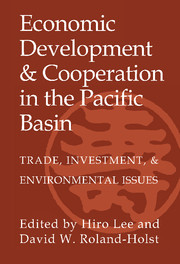 Economic Development and Cooperation in the Pacific Basin
Economic Development and Cooperation in the Pacific Basin Published online by Cambridge University Press: 19 May 2010
INTRODUCTION
Foreign investment in Indonesia is best understood in a historical and geographical context. The phenomena of “exportorientation” and “import-substitution,” the resulting dual economy, the assimilation of “capitalism,” utilization of the country's comparative advantage (natural resource base), protection measures such as import quotas, and concerns over income distribution and regional disparities all have definite historical antecedents in this country.
Having gone through a colonial rule for three centuries, it is not unusual for a country like Indonesia to experience some distrust toward external influence, including foreign capital and investment. This perception prevailed after independence in 1945, although it was muted considerably when the New Order government came to power in 1966. Residual suspicion continued among certain groups of society until the late 1970s, but today's opponents of foreign capital are confined to two types. The first is a small group of vested domestic interests seeking to protect markets rather than foster xenophobia. A second group, more recent and politically active, consists of pressure groups concerned with the social and welfare (distributional) impact of foreign investment. These social interest groups were a significant impediment to the dramatic policy changes of the mid-1980s.
The objectives of this chapter are twofold: to delineate the historical context for modern Indonesian foreign investment policy, and to elucidate the impacts of foreign investment on the country's overall welfare and its distribution between household groups and across regions. The chapter is organized as follows. The next section is devoted to a survey of Indonesia's historical experience with foreign capital and investment, from the 1500s up to the late 1970s.
To save this book to your Kindle, first ensure no-reply@cambridge.org is added to your Approved Personal Document E-mail List under your Personal Document Settings on the Manage Your Content and Devices page of your Amazon account. Then enter the ‘name’ part of your Kindle email address below. Find out more about saving to your Kindle.
Note you can select to save to either the @free.kindle.com or @kindle.com variations. ‘@free.kindle.com’ emails are free but can only be saved to your device when it is connected to wi-fi. ‘@kindle.com’ emails can be delivered even when you are not connected to wi-fi, but note that service fees apply.
Find out more about the Kindle Personal Document Service.
To save content items to your account, please confirm that you agree to abide by our usage policies. If this is the first time you use this feature, you will be asked to authorise Cambridge Core to connect with your account. Find out more about saving content to Dropbox.
To save content items to your account, please confirm that you agree to abide by our usage policies. If this is the first time you use this feature, you will be asked to authorise Cambridge Core to connect with your account. Find out more about saving content to Google Drive.